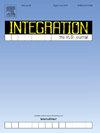扩展芯片板上(e-COB)异构集成的LED与LED驱动器
IF 2.5
3区 工程技术
Q3 COMPUTER SCIENCE, HARDWARE & ARCHITECTURE
引用次数: 0
摘要
在传统的板上芯片(COB) LED电路中,多个LED芯片安装在一个共同的平台上,以实现密集的LED集成,改善散热,降低生产成本。然而,COB LED仍然由传统电源驱动。在这项工作中,提出了扩展芯片板上(e-COB) LED照明系统,其中除了LED外,电子驱动电路也集成到同一平台中。探讨了与线性稳压电源(LRPS)和开关电源(SMPS)的集成。这种集成的结果是电路占地面积的减少,这在LRPS系统中比SMPS系统更明显,因为它需要笨重的电感器。对于LRPS系统,已经证明包含10个环形排列led的e-COB电路的占地面积减少了四倍。e-COB系统在驱动电压为5 V时,由于热源(LED, IC等)与散热器(PCB)之间的直接热通道,而无需穿过封装,因此工作温度降低了约12.4%。e-COB封装方法代表了将LED照明系统的效率和紧凑性提升到一个新的水平的解决方案,它可以很容易地扩展到非照明系统,特别是在重视电气和热效率的地方。本文章由计算机程序翻译,如有差异,请以英文原文为准。
Extended-chip-on-board (e-COB) heterogeneous integration of LEDs with LED drivers
In a conventional chip-on-board (COB) LED circuit, multiple LED dies are mounted on a common platform to achieve dense LED integration, improved heat-sinking, and lower production costs. Nevertheless, the COB LED is still driven by a conventional power supply. In this work, the extended-chip-on-board (e-COB) LED lighting system is proposed, whereby apart from the LEDs, the electronic driving circuit is also integrated into the same platform. Integration with both the linear regulated power supply (LRPS) and switch-mode power supply (SMPS) are explored. The result of such integration is a reduction in circuit footprint, which is more pronounced in the LRPS systems than the SMPS system due to its necessity for bulky inductors. For the LRPS systems, a fourfold reduction in footprint has been demonstrated, for an e-COB circuit comprising 10 LEDs in an annular arrangement. The e-COB system also operates cooler by at the driving voltage of 5 V, due to the direct thermal pathway between the heat source (LED, IC, etc.) to the heat sink (PCB), without having to route through the package. The e-COB packaging approach represents a solution for taking LED lighting system efficiency and compactness to the next level, which can readily be extended to non-lighting systems, especially where electrical and thermal efficiency is valued.
求助全文
通过发布文献求助,成功后即可免费获取论文全文。
去求助
来源期刊

Integration-The Vlsi Journal
工程技术-工程:电子与电气
CiteScore
3.80
自引率
5.30%
发文量
107
审稿时长
6 months
期刊介绍:
Integration''s aim is to cover every aspect of the VLSI area, with an emphasis on cross-fertilization between various fields of science, and the design, verification, test and applications of integrated circuits and systems, as well as closely related topics in process and device technologies. Individual issues will feature peer-reviewed tutorials and articles as well as reviews of recent publications. The intended coverage of the journal can be assessed by examining the following (non-exclusive) list of topics:
Specification methods and languages; Analog/Digital Integrated Circuits and Systems; VLSI architectures; Algorithms, methods and tools for modeling, simulation, synthesis and verification of integrated circuits and systems of any complexity; Embedded systems; High-level synthesis for VLSI systems; Logic synthesis and finite automata; Testing, design-for-test and test generation algorithms; Physical design; Formal verification; Algorithms implemented in VLSI systems; Systems engineering; Heterogeneous systems.
 求助内容:
求助内容: 应助结果提醒方式:
应助结果提醒方式:


